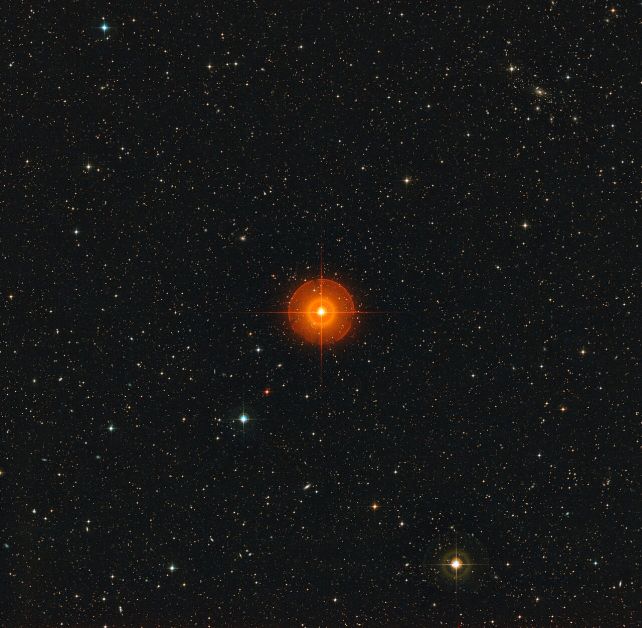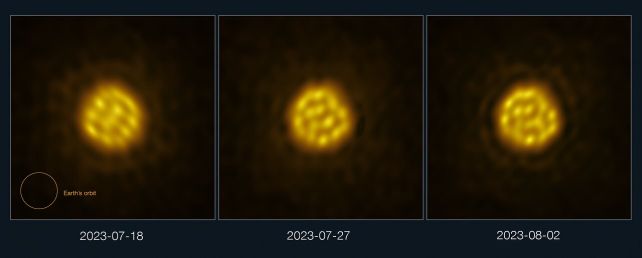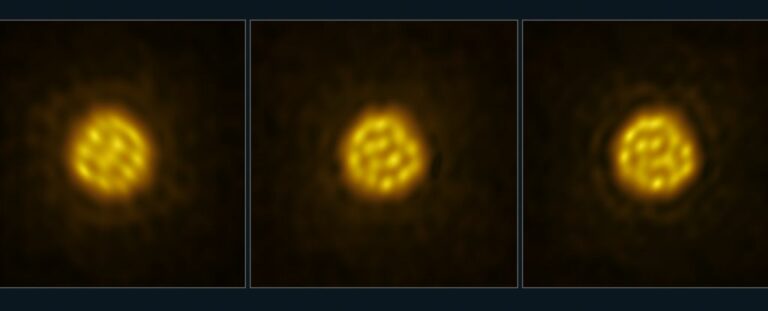Bubbles 75 Times Larger Than Our Sun Erupt on the Surface of This Distant Star
Astro scientists have been recent able to take pictures of this star that is 180 light years away to get evidence of this dynamism in heat systems on the stars surface.
These three scans capture two weeks of changing patterning on one of the most massive objects captured by Hubble: That is, R Doradus, a red giant star roughly 350 times larger and 170,000 times as luminous as our Sun. The bubbles of the heated gas are 75 times larger than the sun and it also shows that the star is going through convection as it nears its death and the drastic motion of the convection currents happens on much shorter timescales than previously believed.
This research is the first attempt to image such processes on a star other than the stars in the Solar System. Observed changes on the surface of R Doradus such as huge convective bubbles, give a superb understanding of the stellar activity.
“This is the first time that observers have been able to directly photograph the boiling surface of a real star,” observes Wouter Vlemmings, a Chalmers University of Technology astronomer based in Sweden. Alas, we never guessed that the data would turn out to be so sharp that so many details of convection on the stellar surface could be in sight!
As for the surface phenomena on stars other than Solar ones, R Doradus is a perfect object of investigation as the object’s size here is significantly larger than that of Solar objects and the activity is more contrasting, meaning that there is more of it on the surface. This makes it possible to capture huge aspects of the scene from a somewhat far distance.

It will help us appreciate how stars undergo what is known as convection in which heat produced in the cores rise to the surfaces of stars. In the Sun, this is done through the convection granules measuring approximately 1000 kilometers (620 miles) across— Texas like size. These granules surface at the centre then disintegrate at the periphery; effective for approximately twenty minutes.
At a deeper level, granulation takes place on a much broader scale still. The size of mesogranules is about 5000 to 10000 Kms and they last for approximately 3 hours. ”Supergranules are about 32,000 km across and last about 20 hours. ”
Sitting 5000 meters up in the Andes of Chile, the researchers, led by Vlemmings, used the Atacama Large Millimeter/submillimeter Array telescope to observe this process on a distant star. Their findings were remarkable.

‘Convection gives these magnificent granular structures on the surface of the sun and as for observing this on other stars…well, that’s been difficult,’ said the astronomer Theo Khouri of Chalmers University of Technology.
“With ALMA, not only have we been able to detect convection granules that are 75 times larger than our Sun directly, but we also managed to measure the speeds of convection granules for the first time in their evolution”.
Large granules are present on R Doradus; the nature of such a scale is unclear. They could be red giant analogues of mesogranules to supergranules or they may be an entirely new class of granulation that may exist only in red giants. There is also the possibility that different types of granules that are used are combined in a way that will produce such an effect.
At the present time, these granules are not easily comparable with any one phase of the solar phenomena. As much as we know they are associated with convection, this paper will reveal the factors that make them massive in size.
Also, the granules shown on the image of R Doradus seem to exhibit the cycle of about a month, much shorter than the solar cycle.
Red giant stars are, however, quite different from the Sun especially because the Sun is still in the middle of it’s stellar life. Red giants are the stars which have gone through the core hydrogen and hence there nuclear reactions are driven by shell burning, this is the burning of hydrogen in a shell around the core. This process leads to the expansion of the star to many times its size on the main sequence. They reckon that the sun, at the end of its evolution process as a red giant, will expand to cover the space within Mars’ orbit.
Currently, our understanding of red giants is very small since the distances between stars imply that we have very few direct observations of them. The short lifetime of convection granules on R Doradus as compared to those on the Sun might be completely natural, given the fact that R Doradus is in a later phase of its evolutionary cycle.
“We are still to fully explain such variations, we remain to realize that convection seems to develop as a star ages, in ways that is not easily expounded,” asserts Vlemmings.
These ARE-ing changes are in turn responsible for the peculiar variations of stars, it is therefore the images of R Doradus that are significant to unravel these.
The research has been published in Nature.
Do not forget to share your opinion with us to provide you with the best posts !




0 Comments